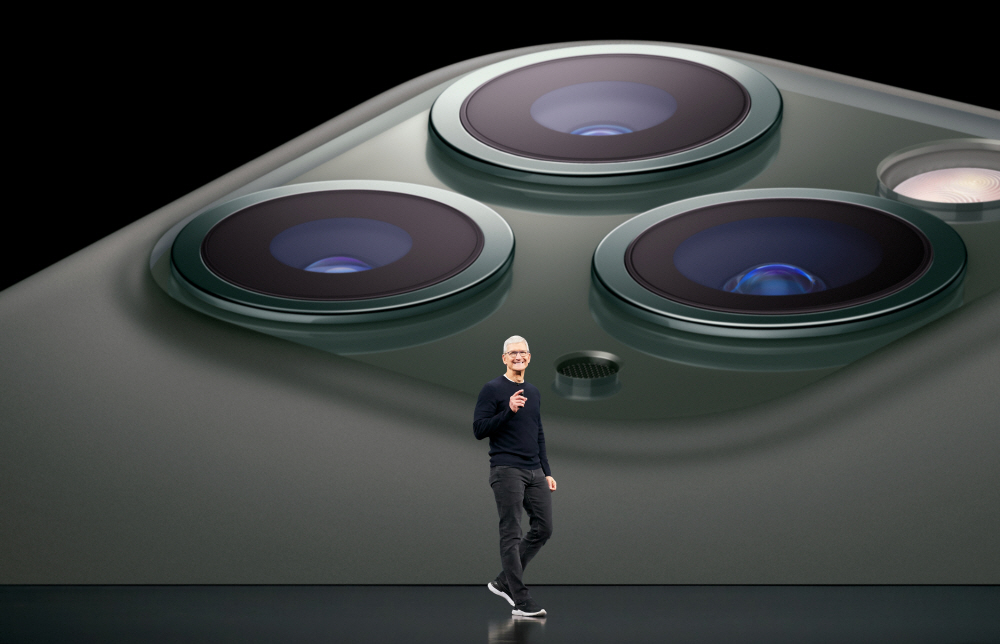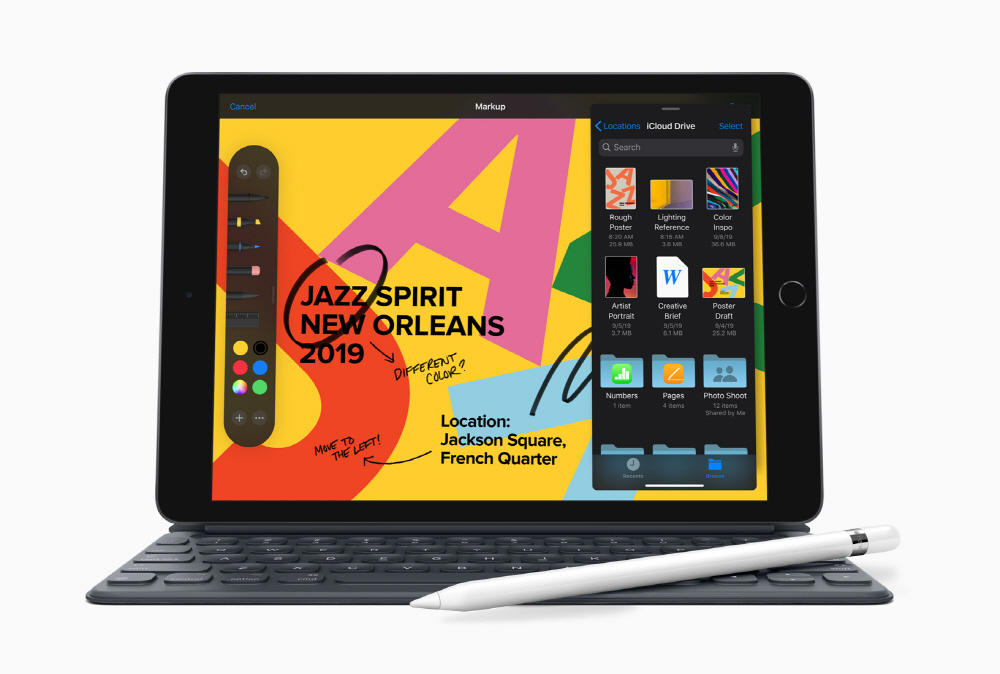
Although Apple has been releasing innovative products so far, it has been pointed out that there is no innovation recently. If so, is this innovation controversy true?
At the Apple New Product Presentation held on September 11, Apple introduced three new iPhones, including the iPhone 11 and 11 Pro and Pro Max, and the Apple Watch Series 5 and 10.2-inch iPad. It was an announcement of a number of new products, but some pointed out that nothing was considered innovation as at the time of the announcement by former CEO Steve Jobs. First of all, I will reorganize from this presentation.
◇ Center of gravity for service rather than hardware = The new 10.2 inch iPad is a 7th generation product. It adopts a 10.2 Retina display and has a 3.5 megapixel screen. It is 2.5 times brighter than the previous model and the viewing angle is 3.7 times wider. The 7th generation model supports the smart keyboard, a genuine keyboard for iPad. SoC is equipped with A10 Fusion. The installed operating system is iPadOS, and it supports Touch ID and Apple Pencil. Of course, you can use Apple Arcade or Apple TV Plus.
The 10.2-inch iPad body is made of 100% recycled aluminum. You can choose between two sizes of 32GB and 128GB, and you can choose from silver, space gray, and gold colors. Pricing starts at $329 and the educational model starts at $299.

The Apple Watch Series 5 features a new Always-On Retina display. The existing Apple Watch saved power by locking the screen, but the newer models always keep the display on. This display is supported by a technology called LTPO (Low Temperature Polycrystalline Oxide). Of course, it is a technology that was also adopted in the Series 4, but the Apple Watch Series 5 is the first time the display is always on. The environment that supports Always-on Retina display is an optical sensor, integrated power management circuit, and three display drivers. It is always on, but the battery lasts 18 hours as before, so the battery can be used all day long.
The Apple Watch Series 5 is also equipped with a compass function for the first time. It is built into the iPhone, but was first applied to the Apple Watch. Also, if you have a cellular model, you can make emergency calls without an iPhone. 100% recycled aluminum is used for the body material. It costs $399 for the GPS model and $499 for the GPS and cellular support model. It will be on sale from September 20th.
IPhone 11 supports 6.1-inch Liquid Retina display and Dolby Atmos. The main dual cameras are a 120,000-pixel 26mm f1.8 wide-angle camera and a 12-megapixel 13mm f2.4 ultra-wide camera. Of course, you can take pictures you like using multiple filters. The video can be shot in a variety of ways, including 4K 60 frame slow motion, time lapse, and cinematic video. It also supports QuickTake, the same name as the Macintosh digital camera released by Apple in the 1990s. IPhone 11 Quick Take is a feature that allows you to instantly switch to video recording while taking a picture. In addition, a 12-megapixel TrueDepth camera was mounted on the front of the main body.
The 2018 iPhone model is equipped with the A12 Bionic chip, but the iPhone 11 is equipped with the next model, the A13 Bionic. The CPU and GPU performance greatly exceeds the existing A12. The battery lasts an hour longer than the iPhone XR. You can choose from six colors: black, yellow, purple, red, and white, and the price is $699.
The top model, the iPhone 11 Pro, is two models. The iPhone 11 Pro Max, which has a resolution of 2688×1242 and a 6.5-inch, and the iPhone 11 Pro, a 5.8-inch model that supports a resolution of 2436×1125. The A13 Bionic was built inside. A machine learning accelerator was added to this, making matrix multiplication six times faster. Processing capacity is 1 trillion FLOPS. The number of transistors in the A13 Bionic is 8.5 billion.
The battery of the iPhone 11 Pro is 4 hours longer than the iPhone XS, and the iPhone 11 Pro Max can use more than 5 hours of battery compared to the iPhone XS Max. These models support fast charging as well.
The camera is triple, wide-angle, telephoto, and ultra-wide. Of course, even if you shoot from the same location, you can take pictures with various angles of view. Prices start at $999 for the iPhone 11 Pro and $1,099 for the iPhone 11 Pro Max. Released on September 20th.
In addition to the hardware, Apple Arcade is available for $4.99 per month, starting September 19th. Apple TV Plus starts service on November 1st, and you can try it free on the 7th. The price is $4.99 per month. In addition to streaming support, you can also download and play offline. In addition, when you purchase a new iPhone, iPad, iPod touch, Mac or Apple TV, Apple TV Plus is provided free of charge for one year. Apple TV Plus content can also be viewed with the Apple TV app.
◇ ‘mobile strategy’ real innovation is Apple gunning = Of course innovation is not anything there was only an intellectual place this presentation came. At the 2016 event that announced the iPhone 7 or Apple Watch Series 2, the New York Times also published a column stating that the new iPhone has some new features, but most of them are the same as the previous devices. But analyst Ben Thompson says the 2016 presentation was far more meaningful than the majority evaluated.
At the 2016 presentation, the iPhone 7’s earphones were removed and AirPods appeared. Apple Watch Series 2 is adding GPS to increase its own features, not iPhone accessories. This is why the future of the iPhone becoming an option in essential items is approaching.
With 2016 as a turning point, Apple’s wearable home accessories category, centered on Apple Watches and AirPods, has doubled revenues, with sales of $22.2 billion in the past 12 months. In other words, in light of business metrics, the 2016 presentation was innovative. Not only wearables, but also the service category have increased revenue over the past three years. 12-month revenue grew from $23.1 billion to $43.8 billion.
Apple declared in 2016 that Apple was not a service company. However, it is pointed out that at the 2019 presentation, it can be seen that Apple is taking a service enterprise strategy. Hardware and service companies have very different strategies. Service companies take a strategy that maximizes the market to intervene, while hardware companies choose a strategy that maximizes differentiation.
From 2016 to 2017, CEO Tim Cook took a strategy as a hardware company. Until then, Apple released the latest model for around $649, and the previous iPhone cut the price by $100. After that, in 2017, Apple introduced the high-end model iPhone X for more than $999. This is a strategy for two markets: customers who want the best iPhones and those who want the highest ranking smartphone in the market. Clearly, the strategy of the service company is not here.
On the other hand, the biggest news at the 2019 presentation is that Apple has cut the iPhone price. The price of the iPhone 11 Pro, the successor to the iPhone X and XS, has not changed, but the price of the iPhone 11, the successor to the iPhone XR, has fallen.
If you look at the prices from iPhone 7 to 11, you can see that the iPhone 7 and 8 went on a $100 discount in two years, but the iPhone XR was cut by $150. The latest model, the iPhone 11, also starts at $699, which is $50 cheaper than the iPhone XR.
| Year of release | 1 year later | 2 years later | |
| iPhone 7 | US $649 | US $549 | US $449 |
| iPhone 8 | US $699 | US $599 | US $449 |
| iPhone XR | US $749 | US $599 | – |
| iPhone 11 | US $699 | – | – |
The same goes for flagship and mid-range model prices from 2016 to 2019. It can be seen that not only the high-end flagship appeared in 2017, but the previous flagship was evaluated as a mid-priced model. Accordingly, after Apple’s second year, the method of selling a $100 discount has also changed.
| Flagship | Middle price tier model | 1 year later | 2 years later | |
| 2016 | US $649 | – | US $549 | US $449 |
| 2017 | US $999 | US $699 | US $599 | US $449 |
| 2018 | US $999 | US $749 | US $599 | US $449 |
| 2019 | US $999 | US $699 | US $599 | US $449 |
The iPhone XR, a mid-range model released in 2018, was a sufficiently high-quality terminal like the iPhone XS in terms of Face ID and processor. However, for that reason, the difference from the iPhone XS is also small, so it could not be a bestseller like the iPhone X. For this reason, Apple cut the price of the iPhone XR by $150, not the $100 discount according to the precedent.
The success of iPhone X was largely driven by sales in China. But on the other hand, in China, where government censorship issues are being discussed, iOS is not a special operating system, and the iPhone is just one of the high-end smartphones. In this regard, it can be said that the iPhone is not the most differentiated in the Chinese market. Apple increased its profits by cutting the price of the iPhone XR in China in early 2019. This is not a product differentiation, but a natural trend in which sales volume increases as prices decrease.
In this regard, Apple is moving from a hardware strategy to a service strategy. It can be said that this year’s Apple also announced Apple Arcade, a subscription game service, and Apple TV Plus, a content subscription service.
Apple’s cost increases as sales increase in Apple Music, but in Apple Arcade, regardless of the number of subscribers and the small number of subscribers, Apple pays a certain amount to game companies, and Apple revenue increases as the number of subscribers increases. That’s why Apple comes out as a strategy to increase sales by lowering the price of the iPhone.
Apple TV Plus, a service that provides its own video content, is not a service that competes with Netflix. It can be said that the purpose of selling the corresponding hardware, Apple TV, is to lead to an increase in subscribers to Apple TV channels that can watch multiple channels including Apple TV Plus.
This Apple event also introduced a system that allows you to purchase a new iPhone at a lower price than before. At the same time, Apple Care Plus is also offered as a set program of iPhone and Apple Care Plus, which has been changed to a subscription model. AppleCare Plus means Apple has turned its user relationship to a subscription. This point also means that Apple is pursuing a strategy as a service company, not a hardware company. Related information can be found here .




